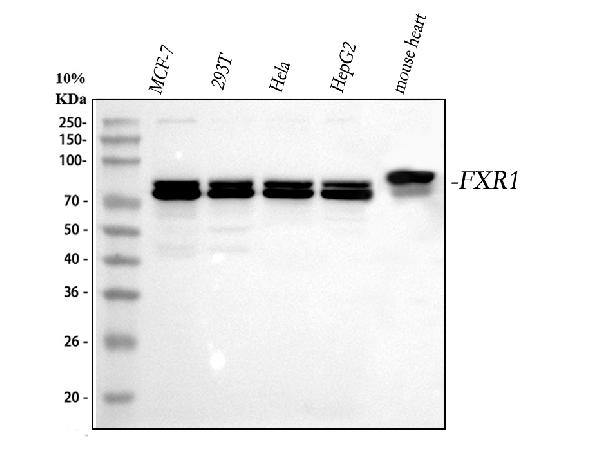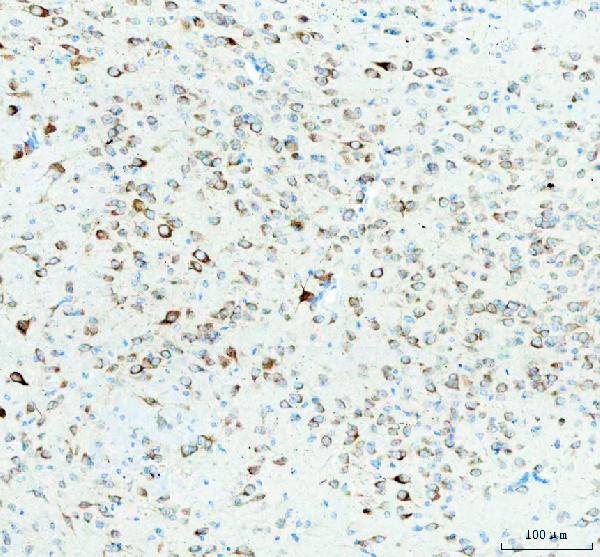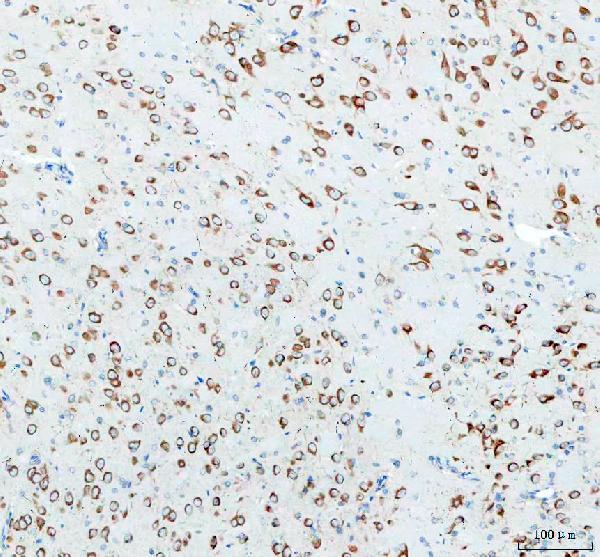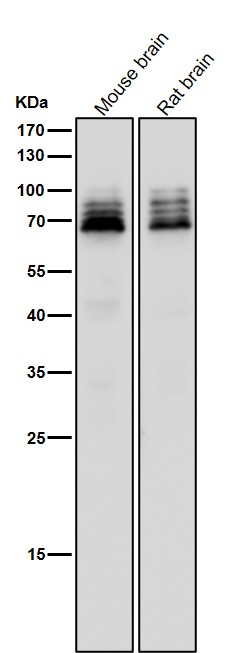Anti-FXR1 Rabbit Monoclonal Antibody
- SPECIFICATION
- CITATIONS
- PROTOCOLS
- BACKGROUND

Application
| WB, IHC, IF, ICC, FC |
|---|---|
| Primary Accession | P51114 |
| Host | Rabbit |
| Isotype | IgG |
| Reactivity | Rat, Human, Mouse |
| Clonality | Monoclonal |
| Format | Liquid |
| Description | Anti-FXR1 Rabbit Monoclonal Antibody . Tested in WB, IHC, ICC/IF, Flow Cytometry applications. This antibody reacts with Human, Mouse, Rat. |
| Gene ID | 8087 |
|---|---|
| Other Names | RNA-binding protein FXR1, FMR1 autosomal homolog 1, hFXR1p, FXR1 {ECO:0000303|PubMed:7781595, ECO:0000312|HGNC:HGNC:4023} |
| Calculated MW | 70-80 kDa |
| Application Details | WB 1:500-1:2000 IHC 1:50-1:200 ICC/IF 1:50-1:200 FC 1:50 |
| Contents | Rabbit IgG in phosphate buffered saline, pH 7.4, 150mM NaCl, 0.02% sodium azide and 50% glycerol, 0.4-0.5mg/ml BSA. |
| Clone Names | Clone: 25F02 |
| Immunogen | A synthesized peptide derived from human FXR1 |
| Purification | Affinity-chromatography |
| Storage | Store at -20°C for one year. For short term storage and frequent use, store at 4°C for up to one month. Avoid repeated freeze-thaw cycles. |
| Name | FXR1 {ECO:0000303|PubMed:7781595, ECO:0000312|HGNC:HGNC:4023} |
|---|---|
| Function | mRNA-binding protein that acts as a regulator of mRNAs translation and/or stability, and which is required for various processes, such as neurogenesis, muscle development and spermatogenesis (PubMed:17382880, PubMed:20417602, PubMed:30067974, PubMed:34731628, PubMed:35989368, PubMed:36306353). Specifically binds to AU-rich elements (AREs) in the 3'-UTR of target mRNAs (PubMed:17382880, PubMed:34731628). Promotes formation of some phase-separated membraneless compartment by undergoing liquid-liquid phase separation upon binding to AREs-containing mRNAs, leading to assemble mRNAs into cytoplasmic ribonucleoprotein granules that concentrate mRNAs with associated regulatory factors (By similarity). Required to activate translation of stored mRNAs during late spermatogenesis: acts by undergoing liquid-liquid phase separation to assemble target mRNAs into cytoplasmic ribonucleoprotein granules that recruit translation initiation factor EIF4G3 to activate translation of stored mRNAs in late spermatids (By similarity). Promotes translation of MYC transcripts by recruiting the eIF4F complex to the translation start site (PubMed:34731628). Acts as a negative regulator of inflammation in response to IL19 by promoting destabilization of pro-inflammatory transcripts (PubMed:30067974). Also acts as an inhibitor of inflammation by binding to TNF mRNA, decreasing TNF protein production (By similarity). Acts as a negative regulator of AMPA receptor GRIA2/GluA2 synthesis during long-lasting synaptic potentiation of hippocampal neurons by binding to GRIA2/GluA2 mRNA, thereby inhibiting its translation (By similarity). Regulates proliferation of adult neural stem cells by binding to CDKN1A mRNA and promoting its expression (By similarity). Acts as a regulator of sleep and synaptic homeostasis by regulating translation of transcripts in neurons (By similarity). Required for embryonic and postnatal development of muscle tissue by undergoing liquid-liquid phase separation to assemble target mRNAs into cytoplasmic ribonucleoprotein granules (PubMed:30770808). Involved in the nuclear pore complex localization to the nuclear envelope by preventing cytoplasmic aggregation of nucleoporins: acts by preventing ectopic phase separation of nucleoporins in the cytoplasm via a microtubule-dependent mechanism (PubMed:32706158). Plays a role in the stabilization of PKP2 mRNA and therefore protein abundance, via its interaction with PKP3 (PubMed:25225333). May also do the same for PKP2, PKP3 and DSP via its interaction with PKP1 (PubMed:25225333). Forms a cytoplasmic messenger ribonucleoprotein (mRNP) network by packaging long mRNAs, serving as a scaffold that recruits proteins and signaling molecules. This network facilitates signaling reactions by maintaining proximity between kinases and substrates, crucial for processes like actomyosin reorganization (PubMed:39106863). |
| Cellular Location | Cytoplasm, Cytoplasmic ribonucleoprotein granule. Cytoplasm, Stress granule. Cytoplasm. Cell projection, dendrite {ECO:0000250|UniProtKB:Q61584}. Cell projection, dendritic spine {ECO:0000250|UniProtKB:Q61584}. Cell projection, axon {ECO:0000250|UniProtKB:Q61584}. Nucleus envelope. Postsynapse {ECO:0000250|UniProtKB:Q61584}. Note=Specifically localizes to cytoplasmic ribonucleoprotein membraneless compartments (By similarity). Localizes to stress granules following phosphorylation at Ser-420 by PAK1 (PubMed:20417602). Adjacent to Z-lines in muscles (By similarity). {ECO:0000250|UniProtKB:Q61584, ECO:0000269|PubMed:20417602} |
| Tissue Location | Expressed in all tissues examined including heart, brain, kidney and testis (PubMed:7781595, PubMed:9259278). In brain, present at high level in neurons and especially in the Purkinje cells at the interface between the granular layer and the molecular layer (at protein level) (PubMed:9259278). |

Thousands of laboratories across the world have published research that depended on the performance of antibodies from Abcepta to advance their research. Check out links to articles that cite our products in major peer-reviewed journals, organized by research category.
info@abcepta.com, and receive a free "I Love Antibodies" mug.
Provided below are standard protocols that you may find useful for product applications.
If you have used an Abcepta product and would like to share how it has performed, please click on the "Submit Review" button and provide the requested information. Our staff will examine and post your review and contact you if needed.
If you have any additional inquiries please email technical services at tech@abcepta.com.













 Foundational characteristics of cancer include proliferation, angiogenesis, migration, evasion of apoptosis, and cellular immortality. Find key markers for these cellular processes and antibodies to detect them.
Foundational characteristics of cancer include proliferation, angiogenesis, migration, evasion of apoptosis, and cellular immortality. Find key markers for these cellular processes and antibodies to detect them. The SUMOplot™ Analysis Program predicts and scores sumoylation sites in your protein. SUMOylation is a post-translational modification involved in various cellular processes, such as nuclear-cytosolic transport, transcriptional regulation, apoptosis, protein stability, response to stress, and progression through the cell cycle.
The SUMOplot™ Analysis Program predicts and scores sumoylation sites in your protein. SUMOylation is a post-translational modification involved in various cellular processes, such as nuclear-cytosolic transport, transcriptional regulation, apoptosis, protein stability, response to stress, and progression through the cell cycle. The Autophagy Receptor Motif Plotter predicts and scores autophagy receptor binding sites in your protein. Identifying proteins connected to this pathway is critical to understanding the role of autophagy in physiological as well as pathological processes such as development, differentiation, neurodegenerative diseases, stress, infection, and cancer.
The Autophagy Receptor Motif Plotter predicts and scores autophagy receptor binding sites in your protein. Identifying proteins connected to this pathway is critical to understanding the role of autophagy in physiological as well as pathological processes such as development, differentiation, neurodegenerative diseases, stress, infection, and cancer.





